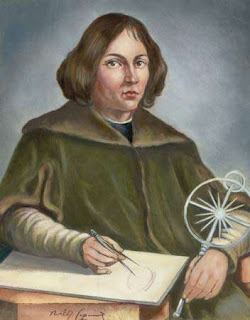Week 9: Space+Art
Although it has
only been half a century since our first space launch, the human admiration of
space and the continuous advancement of astronomy have spawned a wide array of
creations, arts, and ideas. This week’s material explains the origination of
the space dream from the perspective of magnitude, space expedition, private transportation,
and space-related fictions. From Copernicus’s attempt to map out the solar
system, to Elon Musk’s strive toward renewable commercial space travel, we have come a
long way dealing with exploring the unknown. The beauty and intricacy behind
the rocket science, as well as the myriad of unexplored possibiliies have lead its admirers and practicioners to
create art based on the limitless terrain. The ever-increasing knowledge of
space has once again created a new dimension for artistic expression.
 |
| Nicholaus Copernicus |
The World Reknown
movie, Interstellar, is one of the many science fictions that originated with
the space dream. Incoporting the elements such as robots, rockets, spaceships
and space expeditioin. However, what makes this piece stand out is a truly
inspirational storyline that roots of the most complex theory of relativity.
While the majority of the audience possess no such knowledge beyond the formula
E=m^2, the movies plants in a careful set of logic and reasoning to convey the
science behind interstellar travel. In the scene where the astraunauts return
from a planet and discover that their partner has aged 40 years, the director
juxtaposed the short landing time with the drastic biological change to
indicate time as the fourth dimension. The movie even suggests that love
eventual becomes the remedie to the human race, which adds a artistic touch of
humanity to this science fiction.
References
Joteva, Elí. “8 Space pt1 1280x720.” UC
Online, YouTube, 29 July 2013,
www.youtube.com/watch? time_continue=60&v=6ZIqTR332l8.
Post, Hannah. “Reusability: The Key
to Making Human Life Multi-Planetary.” SpaceX, SpaceX, 11 June
2015, www.spacex.com/news/2013/03/31/reusability-key-making-human-life-multi-planetary.
Stern, Marlow. “Neil DeGrasse Tyson
Breaks Down 'Interstellar': Black Holes, Time Dilations, and Massive
Waves.” The Daily Beast, The Daily Beast Company, 11 Nov. 2014,
www.thedailybeast.com/neil-degrasse-tyson-breaks-down-interstellar-black-holes-time-dilations-and-massive-waves.
Tate, Karl. “The Science of
'Interstellar' Explained (Infographic).” Space.com, Space.com, 7
Nov. 2014, www.space.com/27692-science-of-interstellar-infographic.html.
Westman, Robert S. “Nicolaus
Copernicus.” Encyclopædia Britannica, Encyclopædia Britannica,
Inc., 20 May 2018, www.britannica.com/biography/Nicolaus-Copernicus.
Joteva, Elí. “8 Space pt1 1280x720.” UC Online, YouTube, 29 July 2013, www.youtube.com/watch?time_continue=60&v=6ZIqTR332l8.
Post, Hannah. “Reusability: The Key to Making Human Life Multi-Planetary.” SpaceX, SpaceX, 11 June 2015, www.spacex.com/news/2013/03/31/reusability-key-making-human-life-multi-planetary.
Stern, Marlow. “Neil DeGrasse Tyson Breaks Down 'Interstellar': Black Holes, Time Dilations, and Massive Waves.” The Daily Beast, The Daily Beast Company, 11 Nov. 2014, www.thedailybeast.com/neil-degrasse-tyson-breaks-down-interstellar-black-holes-time-dilations-and-massive-waves.
Tate, Karl. “The Science of 'Interstellar' Explained (Infographic).” Space.com, Space.com, 7 Nov. 2014, www.space.com/27692-science-of-interstellar-infographic.html.
Westman, Robert S. “Nicolaus Copernicus.” Encyclopædia Britannica, Encyclopædia Britannica, Inc., 20 May 2018, www.britannica.com/biography/Nicolaus-Copernicus.


I cannot agree more with your opinion of those science fiction movies. As an essential form of art, those movies really enlightened people a lot about what future is gonna be like and what directions may be possible for people to discover. Great work!
ReplyDelete